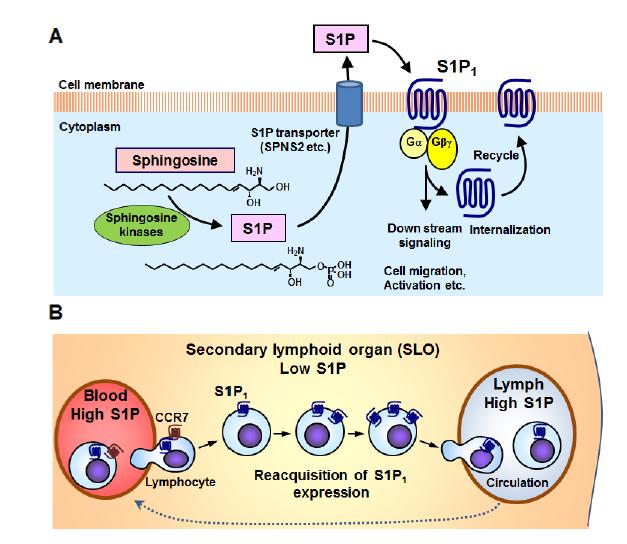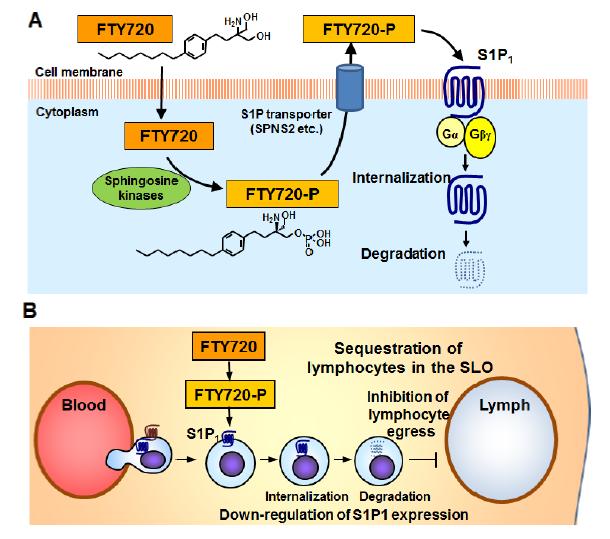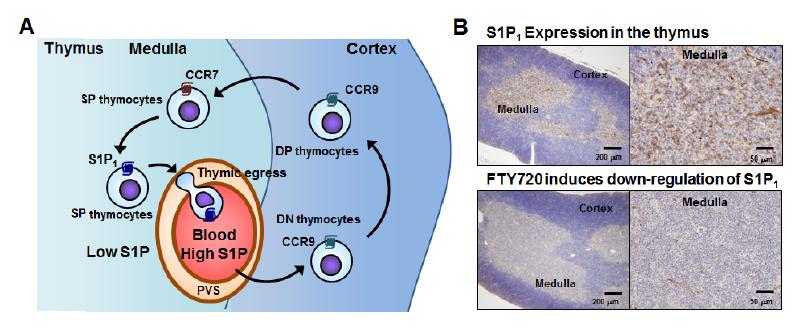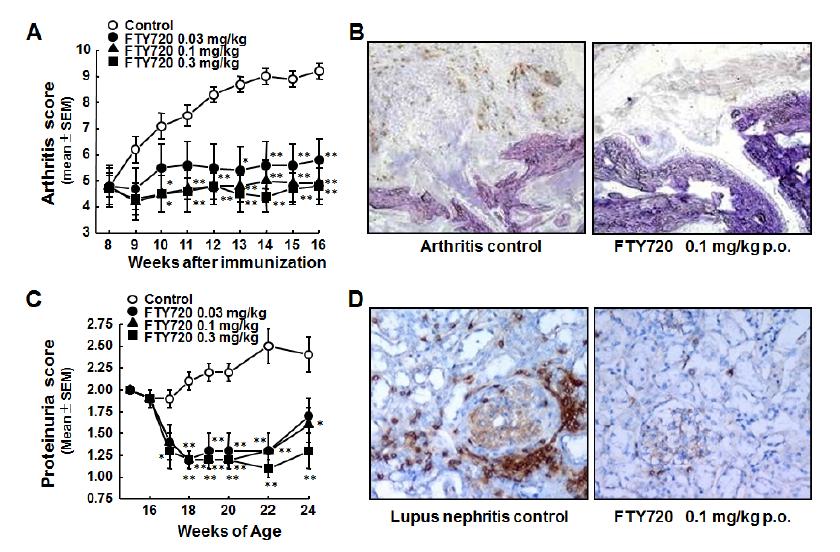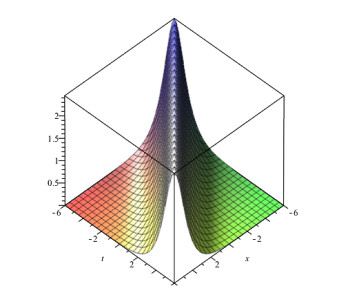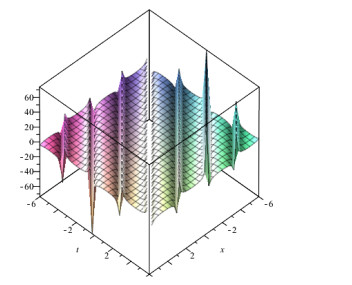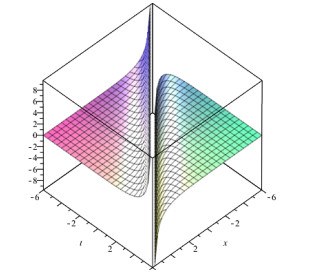1. Introduction
An immunosuppressivenatural product, (2S,3R,4R)-(E)-2-amino-3, 4-dihydroxy-2-(hydroxy- methyl)-14-oxoeicos-6-enoic acid, (myriocin, ISP-I) (Figure 1) was isolated from cultures of Isaria sinclairii, a type of entomopathogenic fungus that is an "eternal youth" nostrum in traditional Chinese medicine [1]. Myriocininhibits antigen-stimulated T cell proliferation in vitro and prolongs rat skin allograft survival for several days in vivo; however this compound is a rather complicated D-amino acid with three successive asymmetric centers and higher dosages induced strong toxicity in vivo [1]. Simplification of the structure of myriocin wasconducted by the elimination of chiral centers and removal of the side chain functionalities [2,3]. These chemicalmodifications of myriocin led to a novel compound, 2-amino-2-[2-(4-octylphenyl)ethyl]propane-1, 3-diolhydrochloride(FTY720, fingolimod hydrochloride) (Figure 1) with more potent immunosuppressiveactivity and less toxicity when compared to myriocin [4,5,6,7,8]. After several years, it has been shown that myriocin inhibitsserinepalmitoyltransferase, the first enzyme in sphingolipid biosynthesis whereas FTY720 showed no effect, suggesting distinct mechanisms of action for these two compounds [5].
FTY720 (0.1 mg/kg or higher, orally) shows a potent immunosuppressive activity in experimental allograft models and various autoimmune disease models including: experimental autoimmune encephalomyelitis (EAE), adjuvant- or collagen-induced arthritis in rats and mice, and lupus nephritis in MRL/lpr mice [9,10,11,12,13]. However, unlike cyclosporin A (CsA), FTY720 does not impair lymphocyte functions such as T cell activation and production of interleukin (IL)-2 by T cells[14,15,16]. The most striking feature of FTY720 is the induction of a marked decrease in the number of peripheral blood lymphocytes (PBL) at doses that show immunosuppressive effects [9,14]. When FTY720 at an oral dose of 0.1 mg/kg or higher is given to rats or mice, the number of lymphocytes in the peripheral blood and thoracic duct lymph decrease markedly whereas the number of lymphocytes in the secondary lymphoid organs (SLO)increases significantly [14]. Intravenous transfusion of fluorescein-labeled lymphocytes into rats reveals that the labeled lymphocytes are accumulated in the SLO by FTY720 [14]. These findings strongly suggest that FTY720 induces sequestration of circulating mature lymphocytes in the SLO, thereby reducing the number of PBL
and T cell infiltration into inflammatory sites [14,15,16]. Accordingly, the sequestration of circulating lymphocytes is presumed be the main mechanism of immunosuppressive activity of FTY720.
Throughout the analyses of the molecular mechanism of FTY720, it has been highlighted that a pleiotropic lysophospholipid mediator, sphingosine 1-phosphate (S1P), and its receptor 1 (S1P1) play an important role in lymphocyte circulation between the blood, SLO, and lymph[17,18,19]. S1P is synthesized by phosphorylation of sphingosine by two isoforms of sphingosine kinase (SPHK1 and SPHK2) [20,21]. S1P acts as ahighaffinity agonistto five related G-protein-coupled receptors, termed S1P1, S1P2, S1P3, S1P4, and S1P5 [22,23] and regulates various cellular processes that are important for immune responses and inflammation [24,25]. Since FTY720 has a structure closely related to sphingosine, it has been demonstrated that FTY720 iseffectively converted to an active metabolite, FTY720 phosphate (FTY720-P, the (S)-enantiomer) by SPHKs [26]. Although FTY720-P is a high affinity agonist at 4 types of S1P receptors (S1P1, S1P3, S1P4, and S1P5) [17,18], FTY720-P induces down-regulation of S1P1 and acts as a functional antagonist at S1P1 [19,27,28,29]. Consequently, FTY720 inhibits S1P1-dependent lymphocyte egress from the SLO and reducesthe number of PBL. This paper summarizes the current understanding of the S1P-S1P1 axis in the immune system based on the analyses of S1P1 functional antagonismby FTY720 and discusses the feasibility of the S1P-S1P1 axis as a therapeutic target for the treatment of autoimmune diseases.
2. Role of S1P-S1P1 axis in lymphocyte egress from the SLO
2.1. S1P and S1P receptors in lymphocyte circulation
Circulation of mature lymphocytes between the blood, SLO, and lymph plays a central role in the establishment of the immune response to foreign antigens. Homing of lymphocytes from blood into the SLO is highly dependent on the interaction between the homing chemokines: CC-chemokine ligand (CCL) 19, CCL21, CXC-chemokine ligand (CXCL) 12, and CXCL13, and their receptors: CCR7, CXCR4, and CXCR5 [30]. On the other hand the reverse pharmacological approaches to define the molecular target of FTY720 have clarified that the S1P-S1P1 axis plays an essential role in lymphocyte circulation [19,30].
S1P is a potent biologically active sphingolipid metabolite which is primarily generated by the phosphorylation of intracellular sphingosine by SPHK1 at the plasma membrane, and SPHK2 at the endoplasmic reticulum, mitochondria and nucleus in most cells [20,21]. S1P, in turn, can be exported by the ATP-binding cassette (ABC) family of transporters [31] or by the S1P transporter spinster homologue 2 (SPNS2) [32] to activate S1P receptors in autocrine and/or paracrine manners. S1P stimulates multiple signaling pathways resulting in calcium mobilization from intracellular stores, polymerization of actin, chemotaxis/migration, and escape from apoptosis; in addition to regulation of diverse cellular processes that are important for immune responses and inflammation [24,25]. In most tissues, including the SLO, S1P levels are kept extremely low (< 10 nM), because S1P is irreversibly degraded by intracellular S1P lyase or dephosphorylated by S1P phosphatase [33,34,35]. Conversely, levels of S1P in the blood are in the μM range. Similarly, significantly high amounts (hundred nMrange) of S1P are found in the lymph [36,37]. These data indicate that a concentration gradient of S1P is existingbetween blood-lymph and SLO [30,38] (Figure 2). Plasma S1P is tightly associated with albumin and lipoproteins, particularly high-density lipoprotein. Although S1P is released by platelets ininflammation, the major source of plasma S1P is red blood cells whereas S1P in the lymph is mainly produced by endothelium [36]. Excessive production of S1P can be induced at inflammatory sites as a result of cell activation by pro-inflammatory cytokines. The S1P gradient between blood-lymph and SLO, as well as over production of S1P at inflammatory sites, appears to play an important role in regulation of circulation and trafficking of lymphocytes(Figure 2).
S1P binds with highaffinities to five related G-protein-coupled receptors, termed S1P1, S1P2, S1P3, S1P4, and S1P5 [22,23]. S1P1, S1P2, and S1P3receptors are widely expressed in the immune, cardiovascular, and central nervous systems. S1P4 is selectively expressed in lymphoid tissues and lungs whereas S1P5 is expressed in natural killer cells, the spleen, and white matter tracts of the central nervous system. The expression of S1P1 mRNA in CD4 T cells is markedly higher than the other S1P receptors, suggesting that S1P1 is the dominant receptor on lymphocytes [19,27,28,29]. It has been reported that lymphocytic S1P1 plays an essential role in lymphocyte circulation, particularly in lymphocyte egress from the SLO and thymus; because mature T cells are unable to exit the SLO and there are no T cells in the periphery in mice whose hematopoietic cells lack S1P1 receptors [19].
S1P (10 to 100 nM) can induce migration of lymphocytes [12,19,28], and lymphocytes from S1P1-deficient miceshowed extremely low levels of migration toward S1P, suggesting that lymphocyte migration is S1P1-dependent [19]. S1P1-dependent migratoryresponsiveness is suggested to be up-regulated in lymphocytes before exit from the SLO, whereas S1P1 is down-regulated during peripheral lymphocyte activation, and this is associated with retention of lymphocytes in the SLO [19,38]. Because S1P1surface expression on lymphocytes is highly dependent on the extracellular concentration of S1P, S1P1 on lymphocytes is down-regulated in the blood and lymph, and up-regulated in the SLO. Consequently, it is widely accepted that cyclical modulation of S1P1surface expression on circulating lymphocytes by S1P contributes to establishing their transit time in the SLO [38] (Figure 2).
2.2. FTY720 acts as a functional antagonist at S1P1
Using reverse pharmacological approaches to clarify the mechanism of action of FTY720, it has been demonstrated that, like sphingosine, FTY720 is a substrate for SPHK1 and SPHK2 and is converted to FTY720-P [26]. The (S)-enantiomer of FTY720-P binds to four subtypes of S1P receptors (S1P1, S1P3, S1P4, and S1P5) but not S1P2, and acts as a high affinity agonist at these receptors whereas FTY720, up to 10000 nM, shows no binding toS1P receptors [17,18,39]. After oral or intravenous FTY720 administration, the plasma concentration of FTY720-P was 2 to 6 times higher than FTY720 [17]. In Chinese hamster ovary (CHO) cells stably expressing human S1P1, S1P and FTY720-P can induce phosphorylation of extracellular signal regulated kinase 1/2 and subsequentlyinduce internalization of S1P1 from the cell surface [19,28,40].
Internalization of S1P1 by S1P is transient and reversible, as internalized S1P1 is recycled and re-expressed on the cell surface within several hours after S1P stimulation (Figure 2). On the other hand, FTY720-P strongly induceslong-lasting down-regulation of S1P1 on the cell surface by internalization and degradation of this receptor [27,28,40,41] (Figure 3).Consequently, FTY720 treatment down-regulates S1P1, pharmacologically creating a temporary S1P1-null state in lymphocytes, providing an explanation for the mechanism of FTY720-induced lymphocyte sequestration into the SLO. The down-regulation of S1P1 by FTY720-P appears to be maintained longer than down-regulation by S1P because FTY720-P, but not S1P, induces degradation of internalized S1P1 [41]. The pretreatment with FTY720-P effectively inhibits the migration of CD4 T cells toward S1P [12,19,28]. Based on these results, it is highly likely that FTY720-P acts as a functional antagonist at S1P1 by internalization and degradation of this receptor, reducing S1P responsiveness of lymphocytes, and inhibiting S1P1-dependent lymphocyte egress from the SLO (Figure 3).
3. Role of the S1P-S1P1 axis in the thymic egress
Intrathymic T cell development is critical for immune surveillance and immune effector function [42,43]. Thymocytes undergo a series of defined developmental stages in the thymus. After entering the thymus, early thymic progenitor cells differentiate into T cell receptor-expressing CD4, and CD8 double-positive (DP) thymocytes in the cortex. Then, CD4, CD8 DP thymocytes mature into CD4 single-positive (SP) and CD8 SP thymocytes in the medulla [42,43]. Mature CD4 SP and CD8 SP thymocytes are shown to be located in the perivascular spaces (PVS) surrounding large blood vessels at the
cortico-medullary junction and the medulla; and exit from the thymus through the PVS and blood vessels in mice [44,45,46,47] (Figure 4). Therefore, the PVS are thought to be a transit pathway for mature thymocytes to emigrate from the thymus. It has been widely accepted that higher amounts of S1P in the blood can stimulate S1P1 expression on mature thymocytes to induce migration and egress from the thymus where S1P concentrations are typically low [48]. As reported previously, FTY720 induces accumulation of CD4 SP and CD8 SP thymocytes in the thymic medulla in mice [49]. Intrathymic injection of fluorescein-labeled thymocytes to mice revealed that FTY720 inhibits egress of mature thymocytes from the thymus to blood [49].
In addition, it is demonstrated that FTY720 inducessignificant accumulation of CD62Lhigh CD69low mature SP thymocytes in the thymic medulla [50]. Immunohistochemical staining using anti-S1P1 antibody revealed that S1P1 is predominantly expressed on thymocytes in the thymic medulla and is down-regulated strongly and rapidly after FTY720 administration [50] (Figure 4). Since FTY720-P internalizes and degrades S1P1 [41], it is likely that FTY720 inhibits the thymic egress by functional antagonism at S1P1. Similarly, the thymic egress is shown to be at extremely low levels in hematopoietic cell- or T cell-specific S1P1knock-out mice [19]. These results indicate that thymic egress is highly dependent on S1P1 expressed on mature thymocytes, especially CD62Lhigh CD69low recent thymic emigrants.
The tissue S1P concentration is maintained at low levels by several S1P-degrading enzymes which are categorized into two classes [51]. The first consists of S1P lyase, which irreversibly cleaves S1P to 2-hexadecenal and phosphoethanolamine; and S1P phosphatases 1 and 2, which dephosphorylate S1P to sphingosine [52]. The second class of S1P-degrading enzymes consists of three phosphatases: lipid phosphate phosphatase (LPP) 1, 2 and 3 [53]. Although S1P lyase resides predominantly in the endoplasmic reticulum, inhibition of S1P lyase activity by 4-deoxypyridoxin (DOP), a vitamin B6 antagonist, or 2-acetyl-4-tetrahydroxy-butylimidazole (THI) causes a marked elevation of extracellular S1P concentration in murine thymus [37]. Because S1P1expression on lymphocytes is highly dependent on the tissue S1P concentration, the treatment with DOP or THI down-regulates S1P1 expression and subsequently induces accumulation of mature thymocytes in the thymus by inhibiting S1P1-dependent thymic egress [37,49]. Consistent with the results obtained by administration of S1P lyase inhibitors to mice, S1P lyase-deficiency in mice shows elevated intrathymic S1P concentration and accumulation of mature thymocytes in the thymus [54]. Consequently, inhibition of S1P1function or disruption of S1P gradients between blood and thymus results in accumulation of mature thymocytes in the thymus because of the missing egress signal. In mice, S1P1 is shown to be expressed in mature CD4 SP or CD8 SP thymocytes by flow cytometry [37,51], whereas S1P lyase is found in the thymic medulla by immunohistochemical staining [55]. Recent immunohistochemical analysis using anti-mouse S1P lyase monoclonal antibody has revealed that S1P lyase is predominantly expressed in non-lymphoid thymic stromal cells in the thymic medulla [50]. In the thymic medullary PVS, S1P lyase was expressed in ER-TR7-positive cells (reticular fibroblasts and pericytes) and CD31-positive vascular endothelial cells [50]. These findings suggest that S1P lyase expressed in the thymic medullary PVS results in low tissue S1P concentration around the vessels and promotes thymic egress via up-regulation of S1P1.
4. Role of the S1P-S1P1 axis in mature lymphocyte egress from bone marrow
As described above, the reduction of PBL by FTY720 is highly dependent on the presence of the SLO. However, it has been reported that FTY720 (1 to 10 mg/kg) decreases the number of PBL in alymphoplasia (aly/aly) mice lacking SLO [56,57,58,59]. Since FTY720 at concentrations of 4000 nM or higher induces the apoptosis of lymphocytes in vitro [49,50], it has been hypothesized that FTY720 (10 mg/kg) decreases PBL in aly/aly mice by inducing apoptosis in lymphocytes. Conversely, two independent studies have demonstrated that a lower dose of FTY720 (1 mg/kg) can also decrease the number of PBL in aly/aly mice significantly [58,59]. Since the blood level of FTY720 in rats or mice treated with 1 mg/kg is less than 200 nM [12], it would seem to be highly unlikely for FTY720 at 1 mg/kg to induce apoptosis of lymphocytes. Accordingly, the hypothesis that FTY720 induces lymphocyte apoptosis is inadequate for explaining the mechanism through which PBL are decreased by FTY720 in aly/aly mice. Thus, the question arises as to whether PBL are sequestered at unknown sites excluding the SLO when FTY720 is administered to aly/aly mice.
Recently, it has been demonstrated that mature lymphocytes were sequestered in the bone marrow of aly/aly mice after administration of FTY720 (1 mg/kg) [60]. These results imply that the reduction of PBL by FTY720 in aly/aly mice is predominantly due to inhibition of the egress of mature lymphocytes from the bone marrow and not through induction of lymphocyte apoptosis. Consequently, it is highly likely that the S1P-S1P1 axis plays an important role in the egress of mature T cells including antigen-specific Th cells from the bone marrow as well as SLO.
5. Therapeutic effects of FTY720 on experimental autoimmune disease models
5.1. Therapeutic effects of FTY720 on EAE
Oral administration of FTY720 is highly effective in EAE, a CD4 T cell-dependent model for multiple sclerosis (MS) [61,62,63,64,65,66]. The development of EAE induced by myelin proteolipid protein (PLP) in SJL/J mice is almost completely prevented by prophylactic treatment with FTY720 orFTY720-P; and infiltration of CD4 T cells into the spinal cord is also decreased [61,62]. When FTY720 (0.1 and 0.3 mg/kg orally) is given after induction of EAE by PLPin SJL/J mice, the relapse of EAE is significantlyinhibited as compared with recombinant mouse IFN-β (10,000 international units (IU)/mouse, subcutaneously); and the infiltration of CD4 T cells are markedly decreased in the spinal cords of EAE mice [62,66]. Similar therapeutic effects by FTY720 are generated in EAE induced by myelin oligodendrocyte glycoprotein (MOG) in C57BL/6 mice [62,66].
In EAE induced by myelin basic proteinin LEW rats, prophylactic administration of FTY720 (0.1 to 1 mg/kg orally) almost completely prevents the development of EAE symptoms; and therapeutic treatment with FTY720 significantly inhibits the progression of EAE and EAE-associated histological changes in the spinal cord [62]. In EAE induced by MOGin DA rats, prophylactic therapy with FTY720 protects against the emergence of EAE symptoms, neuropathology, and disturbances to visual and somatosensory evoked potentials [63,64]. Moreover, therapeutic treatment with FTY720 markedly reverses paralysis in established EAE and normalizes the electrophysiological responses with decreased demyelination in the CNS [63].
5.2. Role of the S1P-S1P1 axis in trafficking of Th17 and Th1 cells in EAE
Infiltration of encephalitogenic CD4 T cells, particularly IL-17-expressing helper T cells (Th17 cells)and interferon (IFN)-γ-expressing helper T cells type 1 (Th1 cells) into the CNS plays a critical role in development and progression of EAE in mice [67,68,69]. FTY720 (0.1 mg/kg or higher, orally) significantly inhibits the development of EAE and markedly reduces the infiltration of Th17 and Th1 cells in the spinal cords of EAE mice [66]. On the contrary, the frequency of Th17 and Th1 cells in draining lymph nodes (DLN) is significantly increased by FTY720, suggesting sequestration of myelin antigen-specific Th17 and Th1cells into the DLN [66].
Recent studies demonstrate a role for the S1P-S1P1 axis in DLN lymphocytes for EAE development when C57BL/6 mice are immunized with MOG [70]. S1P responsiveness of DLN lymphocytes was noticeably down-regulated after MOG immunization; and accompanying reacquisition of down-regulated S1P responsiveness in DLN lymphocytes resulted in mice that developed EAE with significant infiltration of Th17 and Th1 cells into the CNS. These results suggest that reacquisition of S1P1 expression in DLN lymphocytes plays a major role in trafficking of myelin antigen-specific Th17/Th1 cells from the DLN to the CNS in EAE. Prophylactic administration of FTY720 significantly inhibited EAE development and almost completely prevented infiltration of Th17 and Th1 cells into the CNS [70]. FTY720-P inhibited in vitro migration of Th17 and Th1 cells toward S1P via S1P1 but did not affect production of IL-17/IFN-γ or generation of Th17/Th1 cellsfrom naïve CD4 T cells [70]. Consequently, the prophylactic effects of FTY720 on EAE are likely due to inhibition of S1P1-dependent egress of autoreactive T cells from the DLN.
5.3. Role of the S1P-S1P1 axis in astrocytes activation in EAE
Therapeutic administration of FTY720 showed significant improvement of EAE induced by immunization with MOG in C57BL/6 mice [62,66] but only induced a partial reduction of T cell infiltration into the CNS, suggesting the involvement of different mechanisms not mediated via lymphocytic S1P1. Recently, it has been strongly suggested that FTY720-P directly acts as a functional antagonist at S1P1 on neural cells, particularly astrocytes [71,72] because astrocytes express S1P1 and FTY720 can distribute into the CNS beyond blood brain barrier [64]. EAE was attenuated and FTY720 efficacy was lost in CNS mutants lacking S1P1 on glial fibrillary acidic protein (GFAP)-expressing
astrocytes but not on neurons; suggesting that the loss of S1P1 on astrocytes through functional antagonism by FTY720-P is a primary mechanism of FTY720 action [71,72]. Interestingly, S1P can induce production of IL-6, IL-8 and CCL2 in human astrocytic glioma, U373MG cells, and FTY720-P inhibits S1P-induced production of these pro-inflammatory cytokines by down-regulation of S1P1 [73]. These results imply that the S1P-S1P1 axis plays a key role in astrocyte-mediated neuroinflammation.
5.4. Therapeutic effects of FTY720 on other autoimmune disease models
In other chronic autoimmune diseases such as rheumatoid arthritis (RA), systemic lupus erythematosus (SLE), and inflammatory bowel diseases (IBD), it is widely accepted that infiltration of autoreactive lymphocytes in specific target tissues plays an important role in development and progression of the disease. FTY720 almost completely inhibits joint destruction as well as paw edema in adjuvant-induced arthritis and type II collagen-induced arthritis in LEW rats [13,74]. Recently, It has been reported that FTY720 suppressed the progression of arthritis in SKG mice [75]. FTY720 treatment decreased bone destruction, IL-6 and tumor necrosis factor (TNF)-α expression in synovial fibroblast cells, and the in
filtration of inflammatory cells. The analyses of the underlying mechanisms revealed that FTY720 can inhibit arthritis in SKG mice via sequestration of autoimmune CD4 T cells in the SLO, enhancement of helper T cell type 2 (Th2) immune responses, and inhibition of prostaglandin E2 production by synovial cells. Moreover, we also found that FTY720 showed marked prophylactic and therapeutic effects on type II collagen-induced arthritis in DBA/1J mice; with a significant reduction in CD4 T cell infiltration into the arthritic joints and anti-type II collagen antibodies in plasma. Interestingly, FTY720 in combination with anti-murine TNF-α monoclonal antibody showed a synergistic effect on collagen-induced arthritis in DBA/1J mice. These data suggest that FTY720 has a therapeutic potential for RA.
It has been demonstrated that FTY720 shows a marked therapeutic effect on lupus nephritis in animal models for SLE: autoimmune MRL/lpr mice [12,76,77] and NZB/W F1 mice [78]. FTY720 significantly suppressed the production of anti-double stranded (ds) DNA antibodies, reduced the deposition of IgG in glomeruli, and prolonged the lifespan of female MRL/lpr mice. Moreover, it has been demonstrated that KRP-203, a more selective S1P1 agonist attenuates kidney injury and prolongs survival in MRL/lpr mice by reducing T cell infiltration [77]. In aged female NZB/W F1 mice
FTY720 reduced proteinuria and ameliorated histological lesions, but did not affect mesangial expansion or the levels of serum anti-dsDNA antibodies [78]. As FTY720 produces great improvement in murine lupus nephritis models, FTY720 seems to have promising therapeutic potential in human SLE.
There are several reports on the therapeutic effects of FTY720 on IBD models [79,80,81,82]. Therapeutic administration of FTY720 ameliorated the chronic colitis in an IL-10 gene-deficient mouse and this effect is probably due to reduction of lymphocyte infiltration in the colonic mucosa with reduction in IFN-γ production [79]. FTY720 prevented the infiltration of CD4 T cells into the inflamed colonic lamina propria and attenuated the development of dextran sulfate sodium-induced colitis and CD4+ CD62L+ T cell transfer colitis in mice [80]. In a mouse colitis model induced by 2,4, 6-trinitrobenzene sulfonic acid (TNBS), FTY720 shows significant therapeutic effects with a down-regulation of Th1 cytokines [81,82]. Specifically, FTY720 treatment results in up-regulation of FoxP3, IL-10, transforming growth factor (TGF)-β, and CTLA4, suggesting down-regulation of pro-inflammatory signals by inducing CD4+ CD25+ regulatory T cells [81].
As shown in Figure 5, FTY720 shows significant therapeutic effects on type II collagen-induced arthritis in DBA/1 mice as well as lupus nephritis in aged MRL/lpr mice. In both autoimmune disease models, significant amounts of CD4 T cells are found to be infiltrated into the inflammatory sites. FTY720 treatment markedly reduces the infiltration of CD4 T cells into arthritic joints or lupus kidneys. These results strongly suggest that FTY720 shows therapeutic effects on arthritis and lupus nephritis by reducing lymphocyte trafficking to the inflammatory sites. Based on these findings, it is presumed that FTY720 can provide a new therapeutic approach not only for MS but also for other autoimmune diseases such as RA, SLE, and IBD.
6. Clinical result of FTY720 in autoimmune diseases
6.1. Phase 1 studies of FTY720
The phase1clinical studies of FTY20 were performed in stable renal transplant patients maintained on a regimen of CsA and corticosteroids [83,84,85], because FTY720 showed a powerful immunosuppressive activity in various experimental allograft models [9,10,11,12]. The administration of single oral doses of FTY720 (0.25 to 3.5 mg/man) caused a dose-dependent reduction in peripheral blood lymphocytes in the stable renal transplant patients [83]. In the phase 1study on pharmacodynamics, pharmacokinetics, and safety of multiple FTY720 doses in stable renal transplant patients, FTY720 significantly reduced the number of PBLby 85%, which reversed within several weeks after the discontinuation of the medication [84,85]. This dose-dependent reduction of the number of PBL by FTY720 in the human strongly suggests sequestration of circulating lymphocytes into the SLO. Atransient reduction of heart rate was observed in the phase 1 studies of FTY720; however FTY720 subjects showed no major increase in adverse events or changes in renal function as compared with placebo-treated patients [84,85]. Pharmacokinetic measurements revealed that FTY720 displayed a linear relationship between doses and blood concentrations [83,84,85].
6.2. Phase 2 clinical trials of FTY720 in relapsing MS patients
MS is a common, and often debilitating, autoimmune disease of the CNS. Early active MS lesions are characterized by the presence of infiltrated mononuclear cells around venules and small veins, followed by myelin breakdown and astrogliosis, resulting in irreversible disability. The etiology of MS remains unknown, but is widely considered to involve myelin-specific autoimmune destruction mediated by autoreactive T cells [86,87]. IFN-β, cyclophosphamide, or glatiramer acetate is used for MS therapy [88,89].
The first clinical evidence that FTY720 has therapeutic benefits in MS was provided in a 6-month, placebo-controlled Phase 2 trial involving 281 patients with relapsing MS [90]. Patients who received FTY720 at an oral dose of 1.25 mg or 5.0 mg daily had a significantly lower median total number of gadolinium-enhancing lesions on magnetic resonance imaging (MRI) than those who received the placebo. The annualized relapse rates in groups given 1.25 mg and 5.0 mg of FTY720 were 0.35 and 0.36, respectively and were significantly lower than that in the placebo group (0.77). In FTY720-treated MS patients, the number of IL-17-expressing CD4 T cells wasreduced by > 95% in the peripheral blood suggesting tha
t FTY720 inhibits egress of Th17 cells from the SLO [71,91]. FTY720 primarily reduced the numbers of CCR7+ CD45RA+ naïve T cells and CCR7+ CD45RA− central memory T cells in the blood in MS patients; whereas CCR7− CD45RA− and CCR7− CD45RA+ effector memory T cell subsets remained in the blood [71,91]. These results suggest that FTY720 effectively inhibits egress of pathogenic Th17 cells from the DLN but doesnot affect the function of effector memory T cells that play an important role in the prevention of systemic infection.
6.3. Phase 3 clinical studies of FTY720 in relapsing remitting MS patients
Therapeutic effects of FTY720 wereevaluated in a 24-month Phase 3 FREEDOMS study involving 1, 272 patients with relapsing remitting MS [92]. The patients were randomized to receive a daily oral dose of the placebo or FTY720 at 0.5 mg or 1.25 mg. The annualized relapse rates in groups given 0.5 mg and 1.25 mg of FTY720 were 0.18 and 0.16, respectively and were significantly lower than that in the placebo group (0.40). FTY720 at 0.5 mg and 1.25 mg significantly reduced the risk of disability progression over 24-month period. The cumulative probability of disability progression confirmed after 3 months was 17.7% with 0.5 mg FTY720, 16.6% with 1.25 mg FTY720, and 24.1% with the placebo.
FTY720 at 0.5 mg and 1.25 mg showed improved effects compared with placebo in regards to the MRI-related measures. Similar results of FTY720 were obtained during the Phase 2 study in Japanese relapsing MS patients [93,94]. Moreover, therapeutic effects of FTY720 were directly compared with IFN-β-1a in a 12-month Phase 3 TRANSFORMS study involving 1, 292 patients with relapsing remitting MS [95]. Patients were randomized to receive a daily oral dose of 0.5 mg or 1.25 mg FTY720, or a weekly intramuscular injection of IFN-β-1a. The annualized relapse rates in groups given FTY720 0.5 mg and 1.25 mg were 0.16 and 0.20, respectively, and were significantly lower than in the group receiving IFN-β-1a (0.33).Based on these data, FTY720 (Gilenya®/Imusera®) has been approved
as a new therapeutic drug for treatment of MS in more than 75countries including US, EU, and Japan.
The other Phase 3 clinical trials of FTY720 are now ongoing in primary progressive MS patients and in chronic inflammatory demyelinating polyneuropathy (CIDP) patients. Recently it has been reported that FTY720 increases brain-derived neurotrophic factor (BDNF) levels and improves symptoms of a mouse model of Rett syndrome: mice lacking Mecp2, a gene frequently mutated in Rett syndrome [96]. Since FTY720 may improve the functional output of the nervous system, in addition to its well-documented effects on lymphocyte egress from lymph nodes, several investigational clinical studies of FTY720 may be started or conducted in Rett syndrome or other diseases in the CNS.
6.4. Therapeutic potentials of S1P1 functional antagonists in autoimmune diseases
FTY720-P acts as a functional antagonist at lymphocytic S1P1 and inhibits lymphocyte egress from the SLO. Additionally, FTY720 decreases the infiltration of autoreactive T cells into inflammatory sites, thereby exerting powerful immunosuppressive activity. There are some possibilities for S1P1 functional antagonism in non-lymphoid cells in the pharmacological effects of FTY720 because S1P1 is highly expressed in not only lymphocytes but also endothelial cells and neural cells. The mild increases in blood pressure observed in the FTY720 clinical trials may relate to a down-modulation of S1P1 in vascular endothelium [41] which could reduce activation of the vasodilatory endothelial nitric oxide synthetase pathway by endogenous S1P [65,97]. Therefore, it is thought that blocking of the S1P-S1P1 axis in endothelial cells may be useful for cancer therapies because S1P can promote angiogenesis via S1P1.
Since studies in S1P3-deficient mice suggested a major role for S1P3 in heart rate regulation [98], a number of FTY720 analogues having the 2-aminopropane-1, 3-diol framework or a more simplified 2-aminoethanol framework were synthesized [99,100]. The phosphorylated form of KRP-203 was reported to show no affinity to the S1P3 and is expected to be safer than FTY720 [99]. Although KRP-203 was evaluated in phase 2 clinical trials in IBD, until now, there have been no reports on the efficacy and safety of this compound in human studies.
Some selective chemical probes have been designed and synthesized to elucidate the biological function and physiological role of S1P receptors. [101,102,103,104]. These compounds are non-prodrug type S1P receptor agonists and are believed to bind to the S1P receptors directly. Among them, siponimod (BAF312) is thought to be a next-generation S1P receptor modulator, because this compound is an oral selective modulator for S1P1 and S1P5 [105,106,107,108]. The effects of siponimod on brain MRI lesion activity, safety, and tolerability were examined in double-blind, adaptive dose-ranging phase 2 clinical trials in patients with relapsing remitting MS [108]. Siponimod (0.25 to 10 mg/man) reduced the number of active lesions in a dose-dependent manner, indicating therapeutic effects on MS and the P3 clinical trials are now ongoing. Ponesimod, another selective S1P receptor selective for S1P1 and S1P5, is reported to show significant therapeutic effects in the phase 2 clinical trials in not only relapsing remitting MS [109] but also in chronic plaque psoriasis patients [110], indicating an extensive possibility of S1P1 functional antagonists to the therapy for peripheral autoimmune diseases.
Notably, like FTY720, siponimod and ponesimod also showed a transient reduction of heart rate, however these compounds are more selective for S1P1 and have no affinity at S1P3. It is thought that the transient reduction of heart rate observed in FTY720 clinical trials may relate to S1P1-dependent activation of the G protein-coupled inwardly rectifying potassium (GIRK) channels in cardiomyocytes, prior to internalization of the S1P1 by FTY720 [71]. Furthermore, it is reported that S1P1 is expressed strongly whereas S1P3 is only weakly expressed in human cardiomyocytes, suggesting species differences [111]. Because no differences were observed among FTY720 and clinically developing S1P modulators in down-regulation and degradation of S1P1 receptor [112], it can be concluded that the approach of elimination of S1P3 affinity to avoid the transient reduction of heart rate which was observed in FTY720 treatment is considerably difficult.
FTY720 and selective S1P receptor modulators are highly efficacious in MS patients; however dose-dependent increases in adverse events have tempered its utility. It has been demonstrated that FTY720-P induces phosphorylation of the C-terminal domain of S1P1 at multiple sites, resulting in S1P1 internalization, polyubiquitinylation, and degradation [113]. Although the ubiquitin E3 ligase WWP2 plays an important role in degradation of S1P1 by FTY720-P, it is likely that the degradation of S1P1 is not essential for the decrease in the number of PBL, but is critical for pulmonary vascular leak in vivo. Prevention of phosphorylation, internalization, and degradation of S1P1 inhibited vascular leak, suggesting that discrete mechanisms of S1P1 regulation are responsible for the efficacy and adverse events associated with this class of therapeutics. The concept of ligand bias, whereby a ligand stabilizes subsets of receptor conformations to engender novel pharmacological profiles, has recently gained increasing prominence [114]. Consequently, a biased ligand for S1P1 may deliver safer, better tolerated, and more efficacious drugs.
7. Conclusions
FTY720 is a first-in-class S1P1 functional antagonist which was discovered by chemical modification of a natural product. Throughout the analyses of the molecular mechanism of FTY720, it has been highlighted that the S1P-S1P1 axis plays an important role in lymphocyte egress from the SLO and thymus. FTY720-Pinduces down-regulation of lymphocytic S1P1 and inhibits egress of lymphocytes including autoreactive Th17 and Th1 cells from the SLO. Recently, it has been suggested that FTY720-P acts directly as a functional antagonist at S1P1 on astrocytesto attenuate neuroinflammation. In relapsing remitting MS patients, oral FTY720 has shown superior efficacy when compared to
intramuscular IFN-β-1a in regards to reducing the rate of relapse and the number of inflammatory lesions in the CNS. Based on these data, S1P1 functional antagonists including FTY720 appear to provide a useful therapeutic approach for MS, an autoimmune disease in the CNS. In other chronic autoimmune diseases such as RA, SLE, and IBD, it is highly probable that the S1P-S1P1 axis plays an important role in the trafficking and infiltration of autoreactive lymphocytes in specific target tissues. Consequently, S1P1 functional
antagonists may become efficacious and beneficial therapeutic drugs for these autoimmune diseases.
Acknowledgments
The authors thank Kunitomo Adachi, Kyoko Shimano, Noriko Sato, Kana Takemoto, Hiroyuki Utsumi, Atsushi Fukunari, and Yukio Hoshinoin Mitsubishi Tanabe Pharma Corporation for their fruitful collaborations throughout the research.
Conflict of Interest
The authors declare that there are no conflicts of interest related to this study.










 DownLoad:
DownLoad: 